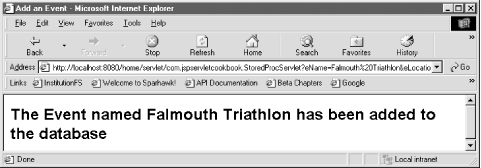Recipe 21.7 Calling a Stored Procedure from a Servlet
ProblemYou want to call a stored procedure from a servlet. SolutionUse the java.sql.CallableStatement class inside a servlet service method, such as doGet( ) or doPost( ) . DiscussionDatabase developers create stored procedures typically for SQL code that they want to execute on a regular basis, similar to a Java developer's reason for creating a method. A stored procedure is a piece of SQL that the database system pre-compiles under a specific name . The stored procedure that I use in this recipe is named addEvent . Naturally, a web developer who is using a database will want to call these stored procedures. The java.sql.CallableStatement class encapsulates a particular stored procedure, so that you can use these tools within JDBC code. Table 21-1 shows the table schema for the table that addEvent uses. The table has four columns : EVENT_ID, NAME, LOCATION, and RACEDATE. Table 21-1. The RACEEVENT database table schema
Example 21-7 shows the addEvent definition using Oracle 8 i 's syntax. This stored procedure takes an event name, location, and date as arguments. It then inserts these values into a new row in the RACEEVENT table.
Example 21-7. A SQL stored procedure designed to add a row to the EVENT tablecreate or replace procedure addEvent(eventname in varchar2, location_ in varchar2,date_ in date) as -- need to do inserts in raceevent begin insert into raceevent values(log_seq.nextval, eventname,location_,date_); end; / If you're using a database tool such as SQL PLUS from the command line, call the addEvent procedure in the following manner: exec addEvent('Falmouth Triathlon','Falmouth MA','26-Jul-2003'); Example 21-8 shows how you can call addEvent in a servlet. The following servlet calls the stored procedure from doGet( ) in its own addRaceEvent method. This method has a java.util.List as an argument. The List contains the values that the code uses as arguments to call the addEvent stored procedure. Example 21-8. A servlet uses CallableStatement to call the stored procedurepackage com.jspservletcookbook; import java.sql.*; import java.util.ArrayList; import java.util.List; import java.util.Iterator; import javax.naming.Context; import javax.naming.InitialContext; import javax.naming.NamingException; import javax.sql.*; import javax.servlet.*; import javax.servlet.http.*; public class StoredProcServlet extends HttpServlet { DataSource pool; public void init( ) throws ServletException { Context env = null; try{ env = (Context) new InitialContext( ).lookup("java:comp/env"); pool = (DataSource) env.lookup("jdbc/oracle-8i-athletes"); if (pool == null) throw new ServletException( "'oracle-8i-athletes' is an unknown DataSource"); } catch (NamingException ne) { throw new ServletException(ne); } } public void doGet(HttpServletRequest request, HttpServletResponse response) throws ServletException, java.io.IOException { String eventName = request.getParameter("eName"); String location = request.getParameter("eLocation"); String date = request.getParameter("eDate"); List paramList = new ArrayList( ); paramList.add(eventName); paramList.add(location); paramList.add(date); try{ addRaceEvent(paramList); } catch (SQLException sqle){ throw new ServletException(sqle.getMessage( )); }//try response.setContentType("text/html"); java.io.PrintWriter out = response.getWriter( ); out.println("<html><head><title>Add an Event</title></head><body>"); out.println( "<h2>The Event named "+ eventName + " has been added to the database</h2>"); out.println("</body>"); out.println("</html>"); } //doGet public Connection getConnection( ){ Connection conn = null; try{ conn = pool.getConnection( ); } catch (SQLException sqle){ throw new ServletException(sqle.getMessage( )); } finally { return conn; } } public void addRaceEvent(List values) throws SQLException{ if (values == null) throw new SQLException( "Invalid parameter in addRaceEvent method."); Connection conn = null; conn = getConnection( ); if (conn == null ) throw new SQLException( "Invalid Connection in addRaceEvent method"); Iterator it = values.iterator( ); CallableStatement cs = null; //Create an instance of the CallableStatement cs = conn.prepareCall( "{call addEvent (?,?,?)}" ); for (int i = 1; i <= values.size( ); i++) cs.setString(i,(String) it.next( )); //Call the inherited PreparedStatement.executeUpdate( ) method cs.executeUpdate( ); // return the connection to the pool conn.close( ); }//addRaceEvent } Example 21-8 gets a Connection from a connection pool using the techniques explained in the prior recipes. The code uses the Connection to create a CallableStatement that the example can use to call the underlying stored procedure: cs = conn.prepareCall( "{call addEvent (?,?,?)}" ); The String argument to the Connection's prepareCall method contains question marks (?) as placeholders for the stored procedure's parameters. The code then calls the CallableStatement's setString( ) method to give these placeholders values. Finally, the code calls the CallableStatement's executeUpdate( ) method to execute addEvent .
The servlet receives values for the new row from request parameters. The following URL calls the servlet with three parameters: eName, eLocation, and eDate: http://localhost:8080/home/servlet/com.jspservletcookbook. StoredProcServlet?eName= Falmouth%20Triathlon&eLocation=Falmouth%20MA&eDate=26-July-2003 Figure 21-5 shows the servlet's output in a web browser. Figure 21-5. The browser output of the StoredProcServlet See AlsoThe JDBC specification: http://java.sun.com/products/jdbc/download.html; Recipe 21.1 on accessing a database from a servlet without a connection pool; Recipe 21.2 and Recipe 21.3 on using a DataSource on Tomcat; Recipe 21.4-Recipe 21.6 on using DataSources with servlets and JSPs on WebLogic; Recipe 21.8 on calling a stored procedure from a JSP; Recipe 21.9 on converting a java.sql.ResultSet object to a javax.servlet.jsp.jstl.sql Result ; Recipe 21.10 and Recipe 21.11 on using transactions in servlets and JSPs; Recipe 21.12 on finding out information about a ResultSet . |
EAN: 2147483647
Pages: 326
